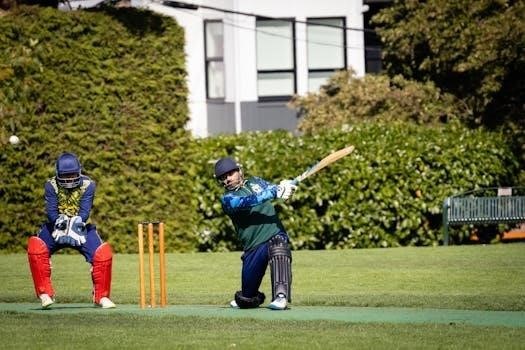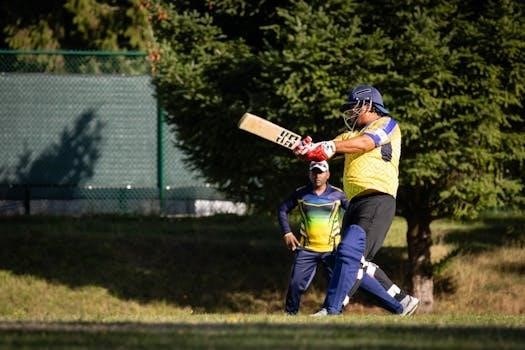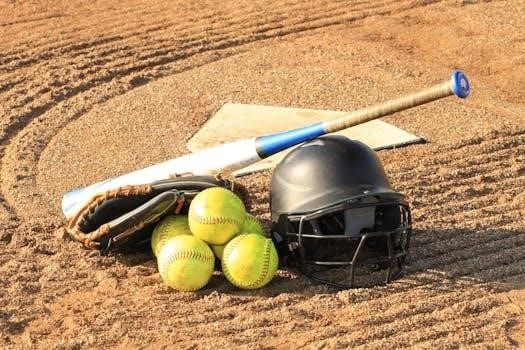Selecting the correct bat size is crucial for performance and safety in baseball. This guide will explore various factors like age, height, and weight to help you choose the right bat. Understanding these elements ensures optimal swing mechanics and better hitting.
Importance of Correct Bat Size
Using the right bat size is paramount for a player’s success and safety. A bat that is too long or too heavy can hinder swing speed and control, leading to poor contact and potential injury. Conversely, a bat that is too short or too light might not generate enough power. Proper bat sizing ensures optimal swing mechanics, allows for better contact with the ball, and promotes confidence at the plate. Ultimately, the correct bat size allows players to maximize their potential and enjoy the game safely and effectively.
Sizing by Age
Age is a primary factor in determining bat size. Younger players typically require shorter, lighter bats for better control. As players age, they generally transition to longer and heavier bats for increased power.
Bat Length Recommendations by Age Group
For players aged 5-7, a bat length of 24-26 inches is generally recommended, while 8-9 year-olds typically use 26-27 inch bats. Players in the 11-12 age bracket often use 30-31 inch bats. Moving into the 13-14 age range, bat lengths of 31-32 inches are common, and 15-16 year-olds may use 32-33 inch bats. Finally, players 17 and older usually use 33-34 inch bats. These are general guidelines and individual preferences should also be considered.
Sizing by Height and Weight
Height and weight are key factors in determining the appropriate bat size. Charts are available to help players find the correct length based on their measurements, ensuring a comfortable and effective swing.
Using Height and Weight Charts
Height and weight charts are valuable tools for selecting the right bat size. These charts typically cross-reference a player’s height and weight to suggest an appropriate bat length. Many online resources and sporting goods stores provide these charts. It’s important to use these charts as a starting point, considering that individual preferences and strength also play a role. Remember that they provide a general guideline and not a strict rule. Some charts also include bat weight suggestions.
Height and Weight Intersection
The intersection of height and weight on a sizing chart provides a more personalized bat size recommendation. This method combines two key physical attributes to refine the selection process. Instead of relying solely on age, considering both height and weight allows for a better fit. This approach is particularly useful for players who are either taller or shorter than average for their age. It helps in finding a bat that is both comfortable and effective for their specific build and strength level.
Bat Weight Considerations
Bat weight significantly impacts a player’s swing speed and power. Understanding the appropriate weight for your skill level is key to maximizing performance. This section will explore the nuances of bat weight.
Understanding Bat Drop Weight
Bat drop weight is the difference between the bat’s length in inches and its weight in ounces. A -10 drop means a 30-inch bat weighs 20 ounces. Lower drop weights, like -3, indicate heavier bats, generally preferred by older, stronger players. Conversely, higher drop weights, such as -10, result in lighter bats, which are easier for younger or less powerful players to swing effectively. Choosing the correct drop weight is crucial for maximizing swing speed and control while minimizing the risk of injury.
Impact of Bat Weight on Performance
The weight of a bat significantly influences a player’s performance. A heavier bat can generate more power, resulting in longer hits but may also slow down swing speed, potentially reducing contact frequency. Conversely, a lighter bat allows for quicker swings and improved bat control, enhancing the chance of making solid contact, although possibly sacrificing some power. Finding the optimal weight is a balance between maximizing power and maintaining swing speed and control which is vital for success at the plate. Therefore, personal preference and strength levels should be considered.

Tee Ball Bat Sizing
Tee ball bats are specifically designed for very young players, typically aged 4-6. These bats are lighter and shorter, usually 24-26 inches long, making them easier for beginners to handle and swing effectively.
Specifics for Tee Ball Bats
Tee ball bats are designed with young players in mind, typically those aged 4 to 6 years old. These bats are significantly lighter, usually weighing between 12 and 14 ounces, and shorter, ranging from 24 to 26 inches in length. The reduced weight and size of tee ball bats ensure that beginners can manage the bat comfortably and develop proper swing mechanics without struggling with excessive weight. Moreover, the length of the bat should be approximately 1-2 inches shorter than the player’s height. This helps the young players to develop their skills.

League and Governing Body Regulations
Various leagues like BBCOR, USSSA, and Little League have specific bat size regulations. These standards often dictate maximum lengths, barrel diameters, and drop weights to ensure fair play and safety.
BBCOR Standards and Requirements
BBCOR, or Batted Ball Coefficient of Restitution, is a standard primarily for high school and college baseball. It regulates bat performance to make it more similar to wood bats. BBCOR bats typically have a -3 drop weight, meaning the bat’s length in inches minus its weight in ounces equals three. These regulations focus on limiting trampoline effect and enhancing safety, ensuring that the bat doesn’t perform too differently than a traditional wooden one, thus requiring more player skill. Compliance with BBCOR standards is essential for these levels of play.
USSSA and Little League Bat Sizes
USSSA, or United States Specialty Sports Association, governs bats for players 14 and under. These bats often have a 2 1/4 inch barrel size, sometimes going up to 2 3/4 inches. Little League bats vary more, generally ranging from 28 to 31 inches in length and 15 to 22 ounces in weight. These standards are designed to accommodate various age groups and skill levels. Both USSSA and Little League have specific rules, so checking the regulations for your particular league is always recommended to ensure you have the correct bat.

Additional Sizing Methods
Beyond age, height, and weight, precise measurements are crucial. Measuring a batter’s height and weight accurately ensures a better fit. This accuracy helps in selecting the most appropriate bat length and weight.
Measuring Height and Weight for Accuracy
To ensure the most accurate bat sizing, precise measurements of both height and weight are essential. When measuring height, have the player stand straight against a wall without shoes. Use a ruler or measuring tape to get the exact height from the floor to the top of their head. For weight, use a scale and record the measurement in pounds or kilograms. These measurements are critical for consulting bat sizing charts or using online tools, as they provide a more personalized recommendation than relying solely on age.
Finding the Right Bat
Finding the correct bat involves using available resources such as online charts and sizing guides. These tools typically consider height, weight, and age to offer personalized bat length recommendations for players.
Using Bat Sizing Charts Online
Online bat sizing charts are invaluable tools for determining the appropriate bat length. These charts often incorporate a player’s height and weight, providing a recommended bat length based on these measurements. Some charts also include age as a factor, especially for younger players. These interactive tools simplify the process, allowing users to input their specific measurements and receive tailored suggestions. Remember to cross-reference with manufacturer guidelines and league requirements. Always double-check the chart’s recommendations before making a final decision.
Bat Weight and Length
The relationship between bat length and weight is crucial. Generally, longer bats are heavier, impacting swing speed. Finding the right balance is key for optimal performance, considering both power and control.
Relationship between Length and Weight
The interplay between a bat’s length and weight is paramount for effective hitting. A longer bat can provide more reach and potentially more power, but it may also be harder to control, especially for younger players. Conversely, a shorter bat can be easier to swing, increasing bat speed, but might sacrifice some power. The key is to find a bat that allows for both comfortable handling and sufficient power transfer. A good balance between length and weight is essential for optimizing a player’s swing mechanics and hitting performance. This balance often depends on the player’s strength and size.
Manufacturer Variations
Bat sizing can differ across manufacturers; therefore, relying solely on stated measurements can be misleading. It’s important to check specific charts and try bats from different brands to find the best fit.
Differences in Bat Sizing Across Brands
It’s crucial to recognize that bat sizing isn’t uniform across all manufacturers. While two bats may be labeled with the same length and weight, their actual feel and performance can vary significantly. This is due to variations in materials, construction techniques, and design philosophies. Some brands may prioritize balance, while others focus on power. Therefore, relying solely on stated measurements can be misleading; Exploring different manufacturers and their specific sizing charts is essential for finding the perfect bat that suits individual needs and preferences. It is best to try out several bats of different brands before making a purchase.

Expert Advice
Seeking guidance from coaches or experienced professionals is highly beneficial. They can offer personalized recommendations based on your individual swing, strength, and playing style. Their insights can significantly improve your bat selection process.
Guidance from Coaches and Professionals
Coaches and seasoned professionals offer invaluable insights into bat selection, often going beyond standard charts. Their experience allows them to assess individual swing mechanics and strength levels, providing tailored advice. They can observe how a player handles a bat during practice, identifying if the weight or length is hindering their performance. Furthermore, they can factor in specific league regulations and playing styles, ensuring the player uses the most suitable bat for optimal results and safety. This personalized approach is often more effective than relying solely on generalized charts.
Selecting the right bat involves considering age, height, weight, and league rules. Consulting charts and seeking expert advice ensures optimal performance and safety. Remember, a proper fit is key.
Choosing the correct bat involves several critical factors. Age is a primary consideration, with different age groups typically needing different lengths. Height and weight also play a key role, as these determine the overall size and strength of the player. League regulations, such as BBCOR standards, further influence bat selection. Understanding drop weight, the difference between the bat’s length and weight, is also crucial. Ultimately, finding the right bat is a personal process, so considering all of these elements will lead to a more informed decision.
